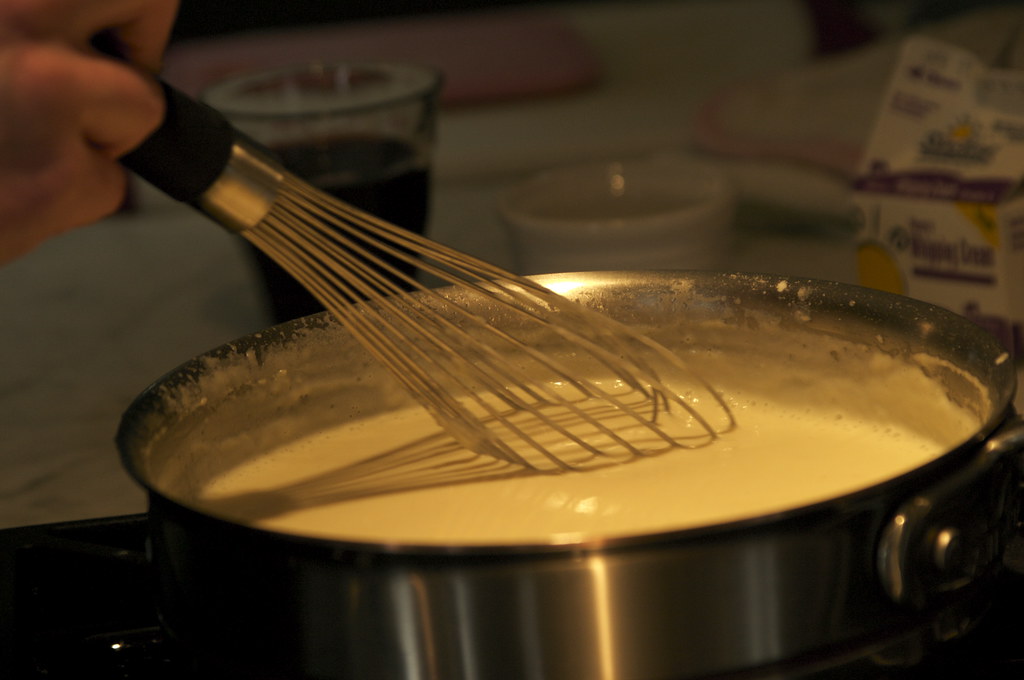The history of this sauce is lost to the ages. Either it was invented by the Marquis Louis de Bechamel, courtier of King Louis XIV, or the nimble royal chefs, having slightly modified the old recipe, dedicated it to the nobleman…
Béchamel is one of the five so-called “mother” sauces, on the basis of which “daughter”, secondary sauces are prepared, about which I will also say a little.
The base for many French sauces, including béchamel, is lightly fried flour in butter. The delicate paste resulting from frying is called roux.
Depending on the degree of frying, the roux comes in white, golden and brown. For our béchamel you will need to make white roux.
What you need:
a frying pan with a thick bottom or a solid sauté pan
whisk
500 ml cold milk
30g butter
30 g flour
salt, freshly ground white pepper, nutmeg
Pay attention to the equal amounts of flour and butter – this is one of the main rules for béchamel sauce. And the milk must always be cold. Pepper is white: in béchamel sauce, it’s the aroma that counts, not the spiciness. The nutmeg will delicately enhance the milk flavour. By the way, the milk for the sauce can be infused beforehand with onions, carrots, cloves and bayleaf.
What to do:
Melt the butter over a medium heat and, as soon as it has slightly foamed, pour in the flour all over the surface. Quickly knead with a spoon or whisk and leave on the heat for 1 to 2 minutes.
Then gently pour in the cold milk while stirring continuously with the whisk. Turn up the heat and, while stirring, bring it to the boil. Don’t worry about lumps! In a few seconds the lumps will separate into a smooth, thick sauce. If it doesn’t, it’s only natural to strain the sauce through a sieve. Some recipes even recommend straining the sauce through a sieve to remove the clots. But that will come later, when the béchamel is fully cooked.
In the meantime, you need to reduce the heat to the very minimum and heat for 40-45 minutes. Yes, the process is not quick and, at first glance, seems superfluous, but it is far from it. During long heating, extra moisture evaporates and the flavour of the flour goes away completely. If this rule is not followed, after the sauce is removed from the heat, it will change its consistency rather drastically – it will thicken.
When the sauce is finished, salt it and add white pepper and a pinch of nutmeg.
Variations on the theme of béchamel
The perfect accompaniment for hot meats, fish, vegetables and pasta dishes, béchamel is ready. But this is not the end of the sauce. Béchamel sauce is used as an ingredient in lasagne, moussaka and many gelatinous dishes.
By the way, the famous and beloved Soviet parade dish Meat à la France is nothing else but a gratin of potatoes with meat. Only it should be, of course, not drowned in mayonnaise-like layered substance, but baked in béchamel sauce. So feel free to prepare a forgotten dish and serve it proudly as a gratin. Just a word of advice – the baking sauce needs to be made a little thicker. To do this, do not reduce the amount of milk, but keep it on the heat a little longer – up to 1 hour.
As I said at the beginning, there are other no less famous béchamel sauces that are made on the basis of béchamel. They are morne, nantua, aurora and subise.
Morne sauce is made by adding raw egg yolks, cream and Gruyere cheese. This sauce is used on grilled fish and seafood, croquettes, poached eggs and baked goods.
Nantua is a béchamel sauce with the addition of delicacy crayfish oil. The famous pike-perch dumplings are cooked in a nantua sauce.
Soubise is a béchamel sauce with stewed onions and cream. Ideal with roast chicken, guinea fowl and veal.
Aurora sauce is a ‘mother sauce’ plus cream, butter and tomato paste. Goes well with pasta, cauliflower and turkey escalopes.

